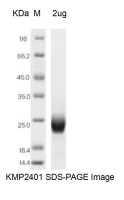Mouse CD160 Protein, His Tag
-
产品编号
KMP2401
-
别名
自然杀伤细胞受体BY55, CD160 antigen, CD160
-
规格
- 50ug
- 100ug
- 200ug
| Alias | 自然杀伤细胞受体BY55, CD160 antigen, CD160 |
| Catalog Number | KMP2401 |
| Product Description | The Mouse CD160 Protein(KMP2401) is produced in HEK293 Cells and the target gene encoding Gly28-Ser160 is expressed with a 6His tag at the C-terminus. |
| Molecular Name | CD160 |
| Species | Mouse |
| Host | HEK293 Cells |
| Size | 50ug, 100ug, 200ug |
| Purity | >95% as determined by SDS-PAGE |
| Purification | Affinity purification |
| Endotoxin | <1.0 EU/ug determined by the LAL method |
| Formulation | PBS, pH7.4 |
| Background | CD160 antigen is a cell membrane protein which contains one Ig-likeV-type(immunoglobulin-like) domain. CD160 is a GPI-anchored lymphocyte surface receptor in which expression is mostly restricted to the highly cytotoxic CD56(dim) CD16(+) peripheral blood NK subset. CD160 is a receptor showing broad specificity for both classical and non-classical MHC class I molecules. CD160 is expressed in spleen, peripheral blood, and smal lintestine. Expression of CD160 is restricted to functional NK and T cytotoxic lymphocytes. CD160 acts as a co-activator receptor for CD3-induced proliferation of CD4+ CD160+ T cells isolated from inflammatory skin lesions. Activated NK lymphocytes release a soluble form of CD160 that functionally impairs the MHC-I-specific cytotoxic CD8(+) T lymphocyte responsiveness. |
| SDS-PAGE |  |
| Predicted Molecular Weight | 15.82 kDa |
| Storage Condition | Aliquot and store at -20℃ to -80℃. Avoid repeated freezing and thawing cycles. |
| Shipping Condition | In general, the proteins are provided as lyophilized powder which are shipped at ambient temperature. They are shipped out in dry ice if supplied in liquid form. |
| Uniprot ID | O88875 |
| References | 1.J. Immunol. 175:4426-4432 (2005) 2.Nature 488:222-225 (2012) 3.J. Exp. Med. 212:415-429 (2015) |
| Function | CD160 antigen Receptor on immune cells capable to deliver stimulatory or inhibitory signals that regulate cell activation and differentiation. Exists as a GPI-anchored and as a transmembrane form, each likely initiating distinct signaling pathways via phosphoinositol 3-kinase in activated NK cells and via LCK and CD247/CD3 zeta chain in activated T cells (By similarity). Receptor for both classical and non-classical MHC class I molecules. Receptor or ligand for TNF superfamily member TNFRSF14, participating in bidirectional cell-cell contact signaling between antigen presenting cells and lymphocytes. Upon ligation of TNFRSF14, provides stimulatory signal to NK cells enhancing IFNG production and anti-tumor immune response . On activated CD4+ T cells, interacts with TNFRSF14 and down-regulates CD28 costimulatory signaling, restricting memory and alloantigen-specific immune response (By similarity). In the context of bacterial infection, acts as a ligand for TNFRSF14 on epithelial cells, triggering the production of antimicrobial proteins and pro-inflammatory cytokines. CD160 antigen, soluble form The soluble GPI-cleaved form, usually released by activated lymphocytes, might play an immune regulatory role by limiting lymphocyte effector functions. |





 0
0
